When anglers choose a particular type of braid and leader, the criteria usually revolves around breaking strain, how well it casts, and to a lesser degree colour and knot strength. Surprisingly few anglers fully understand the inner workings of braid and leader material and exactly what makes each type look feel and fish differently.
When you consider that you’re main line and leader is probably the most important part of your fishing gear, having an in-depth knowledge of what your spooling onto your favourite rod and reel can certainly help contribute to your fishing success.
Braid is made from a material called poly-ethylene, or as you may have heard it in its shorter form PE. When choosing a braid, anglers are often confused with the two main choices on offer – dyneema and spectra.
In reality, both are made from the exact same raw poly-ethylene material and are one in the same. The main difference separating dyneema and spectra lines comes down to how the line has been manufactured and what coatings have been added to the end result. It is these two factors that ultimately set braids apart.
The main two forms of manufacturing difference are whether the PE is fused or braided. Fused or gel spun lines are essentially lengths of braid fused together while a true braided line consists of multiple lengths of line braided together.
The majority of Aussie anglers prefer to use braided lines over fused lines, so I will focus on these.
As mentioned before, the way a braided line is manufactured plays a massive role in how it performs. Probably the biggest factors to consider when looking at the differences between lines are how tightly the braid is weaved together, and how many strands are used within the weave.
The tighter the strands of braid are weaved together the stiffer and more rigid the line gets. The big difference between a loose and tight weave line is not just its stiffness, but also its profile. Loosely braided line tends to be flatter while a tight weave will bring a much rounder profile.
Flat braids are less effective than rounded profile braids as they are less prone to wind knots, easier to tie, and generally cast a lot further as they roll off the spool better. It’s important to remember that there is such a thing as being too tightly woven or too stiff, which can see some braids almost as rigid as a piece of mono.
The tightness of the weave can be hard to judge ‘off the shelf’ as some braids are tight when new but when worn in loose a lot of their original feel and stiffness. This is where your better quality braids stand above the rest as they spool on as if they are worn in already and don’t lose their feel or rigidity after a few trips. For me this is vital as I prefer to run tight weaved lines, like Sunline Castaway, on my spin outfits but prefer a little less stiffness for my bait cast outfits, which run Sunline Momentum and Super PE.
Having a line that is consistent off the shelf is really important as I hate buying a line that feels a certain way then changes shape and feel after two weeks fishing.
Most entry level braided lines run a four strand weave. Moving beyond entry level you begin moving into braid constructions with larger numbers of strands. The more strands equals more strength in the line and eight strand braids are a great option when targeting hard fighting fish, especially near structure.
For heavier lines, such as PE4 and up to 8 stranded braids such as Varivas and Monster Battle, are a bare minimum especially when popping and jigging with heavy gear. The more strands also means more stretch and shock absorption as well, which is often needed with larger hard pulling fish.
Eight strand braids are not just for heavy gear, good quality braids will have strand line right down to 10lb. Eight stranded braid is not the tip of the iceberg and you can move to a 12+ strand braided line, however they have a hollow core compared to the more common braid brands that have a solid core.
The advantage of a hollow core is obviously more strength with a lot more shock absorption, which can be very useful when using big poundages for big fish. Hollow core braid, such as Jerry Brown Hollow also allows the line to be spliced, which can eliminate the need for knots, however most leaders to braid knots such as the PR or FG knot will work perfectly on hollow braid.
While the weave and strand construction plays an important role in braid performance, so too can the coatings that are applied to the line. Different types of coatings can transform the performance of a braided line in many ways.
Wear and tear can be minimised, as many coatings contain a silicon-like gel material that prevents dirt breaking down the integrity of the braid. This type of gel coating also brings abrasiveness to the line.
This innovation in abrasiveness has been a wonder for braid and if you ever fished with braid before it was coated you will understand why many thought it was just too delicate for our Australian conditions.
Some coatings also provide a smooth finish, which can contribute to the tightness of the braid and make it very round and easy to cast.
Finally you have the all-important knot strength. The knot strength ability of a braid is solely determined by the coating used. Before coatings were used, the slick surface of braid made tying leader to braid difficult. Many of the coatings used today are solely designed to create friction between leader and braid and therefore slip less and knot very well.
The main disadvantages with coatings are they add to the diameter of the braid and, more importantly, sometimes inferior braid can be enhanced with the use of a coating. This leaves the angler with a false sense of security, especially if the coatings wear off quickly.
There are a lot of different colours of braided lines. The more common are greens, yellows, and blacks, however brighter colourations are beginning to become popular amongst anglers for various reasons.
Bright colourations can be a big advantage, especially when fishing soft plastics as the extra visibility allows the angler to see those bites before they transfer down the fishing rod. This is particularly helpful when you are vibing or working plastics along the bottom in deep water in windy conditions that create a belly in the line. Strong yellows and reds stick out and make it easy to spot a bite straight away.
Brightly coloured braids are also helpful when trolling as they allow the driver to see where trolled lures and lines are moving or positioned. Deep water jigging braids such as Sunline PE Jigger 8 and Power Pro Depth Hunter are often multi coloured to show the angler depths of water and this can be a massive advantage when jigging deep water and the fish are off the bottom.
Leader material can be just as important as your choice of braid. There is no point getting your braid right without matching it to a good leader. Fluorocarbon and monofilament are the main two choices along with a few hybrids that fall in between.
Fluorocarbon is renowned for its invisibility and abrasiveness compared to monofilament and it is a superior leader. However, when moving up into the heavy poundages fluorocarbon can become quite rigid, which makes it harder to tie rigs like paternosters, which are better suited to monofilament.
Better quality fluorocarbon leaders can be quite supple at times however what is gained in flexibility often means a loss in abrasiveness. Thankfully there are lots of options these days and it’s just a matter of matching the right type of fluorocarbon to the desired species.
There are lots of options out there so make sure you take your time to find the right braid and leader, which will suit your fishing requirements. Don’t just settle for what’s on the spool because when you find what works best for you it will not only raise your confidence in your gear but also your expectations and fishing success.
Reads: 5095
When you’re doing battle using heavy PE against big fish hard running fish you really want to be using an 8 strand braid minimum. For real heavy duty lifting hollow core 12 strand is even better. A Grant Zietsmen image.
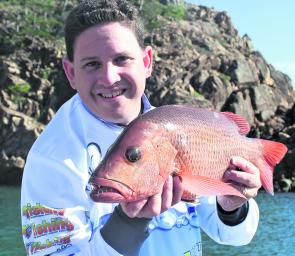
Big jacks require some heavy persuading and this is where your higher quality 8 strand braid has your back, especially when using lighter gear.
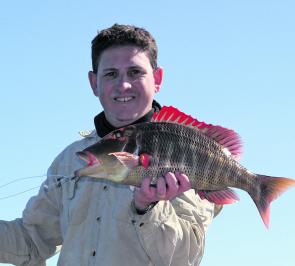
The author with a solid red throat emperor taken on a monofilament paternoster. When you’re using a rig such as the paternoster the flexibility of mono is much better suited than the rigidness of fluorocarbon, especially when you’re fishing leader above 8
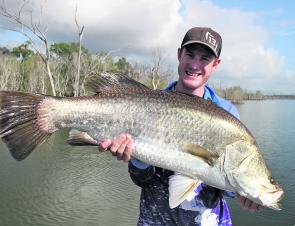
Impoundment barra have created dramas for anglers who are being forced to upsize lines and leaders to cater for their size. Thankfully with the introduction of high quality PE braids and super strong fluorocarbons the fishing is becoming more evenly match
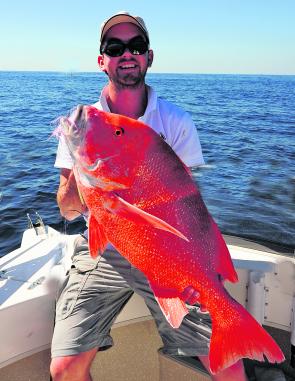
Big reds will test you out big time and this one fell using 80lb Varivas Braid using a PE Tackle Fly. When you’re hooked up to a fish like this it’s reassuring to have confidence in your line selection.
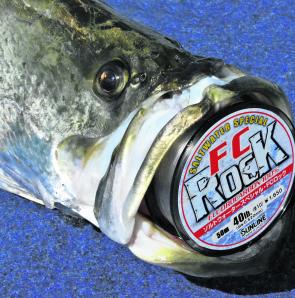
The abrasive mouth of a barra coupled with razor sharp gill-rakers means a quality leader is absolutely essential for success. There is no point in chasing these fish until you get this right.
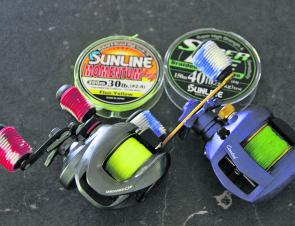
Fluorescent coloured braid brings full visibility to the bite, especially when the wind blows a belly in your line. Being able to watch your line above the water means seeing the bite before registering it on the rod.

I love my GT popping and jigging and it’s a take-no-prisoners approach with super PE 8 stranded line at all times.




